
Atlas F1 Senior Writer
In their more than 50 years of history in motor racing, the Ferrari team have tasted success in nearly every event they have taken part in along the years. However, despite several attempts in the past, the historic Italian squad have never emerged victorious in the most famous race of them all, the Indy 500. Atlas F1's Thomas O'Keefe looks back at Ferrari's history at Indianapolis
Although it is difficult to imagine today because the Ferrari brand name is one of the most famous in the world, when Ferrari first came to the Speedway for the 1952 Indianapolis 500 on May 30, 1952, Scuderia Ferrari was in its infancy.
On September 11, 1949, Alberto Ascari won the Italian Grand Prix at Monza in a Ferrari 125, which had all the bells and whistles we were to come to associate with Ferrari: the blood red paint and the black prancing horse insignia on a yellow shield, a fabulous-sounding supercharged V12 engine, overhead camshafts, huge drum brakes, chrome wire wheels and the egg crate grille which is still found as a styling feature on Ferrari production cars.
Earlier in the same year, in June 1949, the first post-war Le Mans 24-hour endurance race was won by the No. 22 Ferrari called the 166 MM Barchetta ("little boat" in Italian), driven by Lord Selsdon and Luigi Chinetti, a race that Ferrari later won six years in succession, from 1960 -1965. Although the 1949 Ferrari Le Mans team was on paper a two-driver effort, in fact Luigi Chinetti was the ironman for the team and drove the little boat for an incredible 23 hours of the 24-hour race.
As with many of the men with whom Enzo Ferrari worked, Chinetti was to forge a long relationship with the marque, and as an Italian-American, was the man who would plant the Ferrari Flag in the United States and ultimately bring Ferrari to Indianapolis. Building upon the reputation he had gathered as a Ferrari sports car driver, Chinetti became Ferrari's dealer in the United States and imported and sold Ferrari customer cars to sports car enthusiasts all over the country, from Greenwich, Connecticut to Beverly Hills, California through his company, Luigi Chinetti Motors, Inc., 780 Eleventh Avenue, New York City.
It was Luigi Chinetti - still driving sports cars in his forties for Ferrari in events as strenuous as the Carrera PanAmerica endurance race in Mexico while simultaneously establishing Chinetti Motors as a Ferrari dealership - who convinced Enzo Ferrari to come to Indianapolis as part of Ferrari's marketing program to sell more of its cars to American customers pursuant to the car dealers' well-known motto: win on Sunday, sell on Monday. What would one of these Ferrari customer cars have cost in its day? An original bill of sale for a Ferrari 330 GT recently offered at auction showed a Chinetti Motors invoice, shipping by boat from Italy included, in the amount of $7,875!
Lured to Indianapolis by the prospect of boosting sales of its customer cars in America, Ferrari specially prepared four Ferrari 375 Grand Prix cars for the assault on Indy. As it happened, the brand new Formula One World Championship had begun in 1950 (which, by the way, for the years 1950-60 included the Indianapolis 500 as a race counting for the World Championship) and towards the end of the 1951 season, Ferrari found itself at the top of the heap, having begun to supplant Enzo Ferrari's former employer, Alfa Romeo, as the leading Grand Prix car. The tide began to turn in the struggle between Alfa Romeo and Ferrari on July 14, 1951 at Silverstone, where the Ferrari 375, 4.5 litre, V12 of Jose Froilan Gonzalez won its first Formula One event, the British Grand Prix.
Which meant that the Ferrari 375's with the 4.5 litre unsupercharged V12 engine had no place to race but Indianapolis in 1952 so Ferrari thought, why not listen to Luigi Chinetti and give it a try. A four-car team of modified Ferrari 375's was prepared for the 1952 Indy 500: one car was the factory entry for Alberto Ascari, Ferrari's chief driver, the other three were privateer entries for American Indy car owners Howard Keck, Kennedy Tank Company and Gerry Grant of Grant Piston Ring. Although Johnnie Parsons tried to get the Grant Piston Ring Special into the race he did not get it qualified and Parsons ended up driving the Jim Robbins Kurtis roadster instead, finishing tenth. Johnny Mauro, who was Kennedy Tank's driver, failed to make the race at all. Bobby Ball, driving for Howard Keck, couldn't qualify his Ferrari and drove the Rotary Engineering Offy in the race and finished thirty-second.
Alberto Ascari did manage to qualify his No. 12 Ferrari 375, but he ended up in nineteenth position in a field of thirty-three cars and even that achievement was a near thing. Indeed, larger Weber carburetors and an intake manifold to hold them were shipped over from Italy and an enlarged airbox was literally hammered out of the hood scoop sheet metal so that the new parts could be nudged into place under the Ferrari hood. But it turned out that those carburetors, which only Ascari's factory Ferrari had, improved performance enough to get the car into the field.
As a rookie, Ascari amazed Indy regulars by turning in four remarkably consistent qualifying laps, the last two being identical times. But the team was so rushed that in the traditional qualifying picture taken by the Speedway photographer, the prancing horse shield had not yet been painted on the side of the car, although the words "Ferrari Special" were emblazoned under the roughly sculpted hood scoop.
In the end, the novel and fastest cars at the 1952 Indy 500 - the Novi and the Cummins Diesel - were out of the race before it was even half over and the third car that was a departure from the norm - Ascari's Ferrari Special - was also out of the race by lap 41, after his right rear wheel hub flange broke on those beautiful chrome Italian wire wheels, leading Ascari to spin the car into the infield at Turn 4 kicking up the dirt, the car in full opposite lock as he tried vainly to save the car from the slide. Although the Ferrari finished an ignominious 31st place, the wise men of Indy liked what they saw of Ascari as a driver since with not even one-quarter of the race over he had run as high as eighth place before the rear wheel hub gave way. Ironically, the Grant Piston Ring Ferrari 375 owned by Indy regular Gerry Grant had magnesium wheels fitted in place of the more fragile-looking wire wheels and had the works Ferrari followed the example of the locals it might have been Ascari and not Michael Schumacher who would have been the first driver to win for Ferrari at Indy.
How close could Ascari have come to winning Indy? In his recent biography entitled Alberto Ascari: Italy's Great Double Champion, Atlas F1's Karl Ludvigsen calculated that Ascari had averaged 128.71 mph as he moved up through the field in the first 40 laps and was counting on fewer and faster pit stops given the good fuel milage being achieved by the Ferrari; by contrast, the winner of the 1952 Indy 500, Troy Ruttman, had averaged 128.92 mph. Ludvigsen quotes Sam Hanks, who placed third in the 1952 Indy 500 and won the 1957 Indy 500, as to Ascari's prospects: "Ascari showed me enough in the 100 miles he lasted at the Indianapolis 500 to let me know he was equally at home on our speedway as on the road circuits of Europe. If he hadn't broken that wheel I firmly believe he would have had a lot to say at the finish."
Although the four modified Ferrari 375's that were brought to Indy did not set the world on fire in 1952, the cars went on to live colorful lives. One of the cars ran at Pikes Peak driven by Pikes Peak specialist Johnny Mauro, one of the cars was driven by Carrol Shelby in hill climbs, on the beach at Daytona for speed trials and competed in the 1958 Monzanapolis Race of Two Worlds at the banked oval at Monza in Italy. Another of the cars became a movie star in The Racers, the 1955 movie starring Kirk Douglas. And one of the Ferrari 375's, now bearing No. 35 and thought to be the car Johnny Mauro ran at Pikes Peak, is on display in the Hall of Fame Museum on the grounds of the Indianapolis Motor Speedway for all to see.
Although disappointed with the first outing in 1952, Enzo Ferrari did not give up and kept the assault on the Indianapolis 500 on his agenda for literally the rest of his life. Ferrari sports cars kept winning major sports car races like Le Mans, the Mille Miglia and the Targa Florio, but when Memorial Weekend would come around Ferrari often had a card to play. In 1954, Luigi Chinetti wanted to run a further modified V12 Ferrari built up to look like an early version of the Ferrari 553/555 "Squalo" of the period, as a non-factory effort for Luigi Villoresi, who drove a Maserati 250F and the Lancia Grand Prix car during the 1954 Formula One season. Villoresi had previously competed at Indy in the 1946 race in a Maserati Typo 8CL, finishing in seventh place. But Villoresi never qualified the 1954 entry and again Ferrari did not get a chance to challenge Indy.
In 1956, Ferrari renewed its quest for recognition at Indy by working on a hybrid Italo-American car called the "Bardahl Ferrari Experimental", to be driven by Dr. Giuseppe "Nino" Farina, the first Formula One World Champion in 1950 when he drove the Alfa Romeo 158. Farina had run his last race a year earlier at the Belgium Grand Prix on June 5, 1955. In 1955, the hottest Indy roadster builder was Californian Frank Kurtis, and Nino Farina, with sponsorship supplied by the Bardahl Oil Company's office in Florence, Italy, commissioned Kurtis to build a special Indy-style roadster chassis that would be matched with a Ferrari engine, thus combining the best of both worlds. The Kurtis KK500D chassis was actually shipped from Glendale, California to Maranello, Italy where the Ferrari factory installed an inline 4.4 litre, 6-cylinder, Type 121 engine that was used in the Ferrari sports cars that ran the endurance races. The Bardahl-Ferrari was airfreighted by Flying Tiger Lines into Indianapolis on May 12, 1956, about two weeks later than most cars entering the Indy 500, which was held that year on May 30, 1956.
After these dismal runs at the Indy 500 in the 1950's, Enzo Ferrari focused his attention on building at Ferrari first a sports car powerhouse which dominated endurance racing at Le Mans for much of the 1950's and 1960's and later on a Formula One dynasty which won World Championships in 1952, 1953, 1956 (Lancia-Ferrari), 1958, 1961, 1964, 1975, 1977 and 1979.
In the 1960's, Ferrari did not enter a car at the Indy 500 but interesting events were going on behind the scenes involving Ferrari during the month of May leading up to the 1963 Indy 500 which almost ended up with the Ford Motor Company acquiring Ferrari. By 1963, Ford had teamed up with Lotus, the British Grand Prix team that was then the World Championship constructor, to come up with a revolutionary rear-engined Indy car powered by a stock-block Ford Fairlane engine that was destined to revolutionize the Indianapolis 500. Ford had made the policy decision in 1963 to go racing in a big way and had a basic choice before it: make or buy a Ford Racing Division.
Enzo Ferrari, now 65 years old, was open to a collaboration with Ford, as the American auto giant offered the kind of financial stability Ferrari needed to sustain his racing and production car operations. On April 10, 1963, Enzo Ferrari was contacted by Ford Italy which proposed what in today's business parlance would be called a Strategic Alliance between the companies. For the next month, Ford did "due diligence" on Ferrari, sending a research team over from Dearborn to Maranello.
By May 15, 1963 (just six days before the Lotus - Fords of Jim Clark and Dan Gurney qualified at Indy for the first time), the deal had gotten far enough along that an agreement was signed setting up two new companies: Ford-Ferrari (manufacturer of GT cars) and Ferrari-Ford (the racing division). On May 20, 1963, the translators went to work on the detailed transactional documents and it was at that point that Enzo Ferrari's side discovered language in the agreements that he regarded as robbing the Commendatore of his independence in running the racing division. Ford balked when Ferrari asked about his autonomy and Ferrari killed the deal; Ford's executives got the word at Indy while the Lotus-Ford was preparing for the May 30, 1963 Indy 500. By 1969, Fiat had acquired Ferrari. By the way, the price Ford offered for Ferrari back in 1963 was $18 million. Recently, when Fiat was considering a public stock offering for its Ferrari subsidiary on the Milan stock exchange, Ferrari was valued at over 2 billion dollars!
But the challenge of the Indy 500 still gnawed at the Commendatore and in the summer of 1985, when he was 87 years old and in the midst of yet another of his periodic political disputes with the sporting authorities, Ferrari announced that he was going to build a 2.65 litre, V8 turbo, designed especially for Indianapolis.
In a deja vu kind of way, Ferrari went about this latest iteration of the Indy project in a manner that was reminiscent of the 1956 Bardahl-Ferrari effort. This time, a March-Cosworth Indy-style chassis was brought under wraps from Ohio to Maranello with the cooperation of Bobby Rahal's Budweiser/Truesports team (which would go on to win the 1986 Indy 500) and Ferrari's Austrian-born designer Gustav Brunner (now Technical Director of the Toyota Formula One team) was assigned to reverse engineer the March and combine the redesigned chassis with a V8 turbo to create the Ferrari "Formula Indy" car. In March 1987, the motoring press was invited to Fiorano, Ferrari's private test track, for a demonstration run, with the car being driven by the late Michele Alboreto of Ferrari's Formula One team. But then John Barnard was hired away from McLaren by Ferrari as its new chief designer, and he directed that the V8 turbo Indianapolis project be put on the back burner while he focused on Ferrari's Formula One car.
So when the Indy 500 was run on May 24, 1987, the Ferrari V8 turbo Formula Indy was not in the field; when Enzo Ferrari died on August 14, 1988, the dream of winning at Indianapolis seemed to have died with him. Although the car never made it to Indianapolis it is still called the Ferrari Formula Indy and is on display in the Galleria, a museum in Maranello affiliated with the Ferrari factory which is devoted to the preservation of Ferrari race cars of all kinds. The 2.65 litre, V8 turbo engine developed in the course of this Indy project did not go to waste as it formed the basis for the Alfa Romeo engine introduced into Indy-style racing in the 1990 Indy 500, as the powerplant in the March-Alfa Romeo cars owned by Pat Patrick and driven by Al Unser, Sr. and Roberto Guerrero.
Will Ferrari ever attempt another run at the Indy 500 itself? If Michael Schumacher has his say, the answer would emphatically be in the negative since he has publicly stated that although he admires the drivers who run close to the walls in the Indy 500, he considers racing around the 1909 vintage oval track at 230 mph to be too dangerous and not his cup of tea.
But then there is another member of the Ferrari corporate family, Maserati, which has been owned by Ferrari since 1997, that just might be interested. Maserati has a very distinguished history at the Indianapolis Motor Speedway, preceding even Ferrari's attempts in the 1950s. Luca di Montezemolo, the President of Ferrari, has let it be known that he has made it a top priority of his stewardship to revive the distinguished Maserati trident, a marque which has not only run well at Indy but also had many memorable victories in the classic Maserati 250F Grand Prix car.
It should be noted that Alfieri Maserati himself entered a 16-cylinder Maserati for European Grand Prix star Baconin Borzacchini in the 1930 Indy 500 but it was out after 7 laps with magneto problems. The other Maserati in the 1930 race was an 8-cylinder car, privately-entered and driven by Letterio Cucinotta, and it did better than the factory team and finished twelfth, albeit 15 laps down.
But by the late 1930's, Maserati was back at Indianapolis at a time when the European cars were more advanced than the home-grown Speedway regulars and Maserati produced one of the winningest cars ever to run at the Speedway. Wilber Shaw won the 1939 Indy 500 in the "Boyle Special" 8-cylinder Maserati 8CTF, painted a distinctive maroon with cream trim, after leading 51 of the 200 laps. A year later the 1940 Indy 500 was won by the same car and driver, making Shaw the first back-to-back winner of the Indy 500 and a three-time winner of the event. Like the Ferrari 375 Indy challenger, the Maserati Boyle Special is also on display in the Speedway's Hall of Fame Museum.
With the Indy Racing League now gathering to itself powerplants from Japan and America, wouldn't it bring a smile to the late Commendatore, Enzo Ferrari, to have one of his Italian V8's on the grid again at Indianapolis, to once and for all conquer the track that had bested him so many times. Since Luca di Montezemolo, like Enzo Ferrari and Luigi Chinetti before him, knows how important the United States market is to the success of his company and its Fiat affiliates, don't be surprised some year if the throaty but sweet sounds of Italian engines come to Indy not once but twice a year to complete the quest Enzo Ferrari set out on with his old friend Alberto Ascari 50 years ago this summer.
Ferrari's victory at the Indianapolis Motor Speedway in the inaugural SAP U.S. Grand Prix on September 24, 2000, may have appeared to the uninitiated to have been beginner's luck but in truth luck had little to do with it. When Michael Schumacher took the checkered flag from Tony George that day, it was the culmination of almost 50 years of the legendary Italian automaker trying to conquer the Speedway and the country within which the race took place - America.
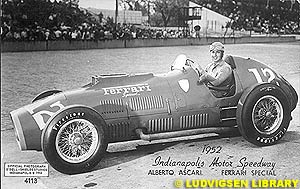 Enzo Ferrari, before World War II, had been the direttore sportivo for Alfa Corse, the highly successful Alfa Romeo Grand Prix team of the 1930's, which Ferrari had molded into a winner by recruiting engineers like Vittorio Jano and drivers like Tazio Nuvolari, Rudolf Carracciola, Louis Chiron, Giuseppe Campari and Antonio Ascari. But once the bombs stopped falling in Europe, Ferrari, 50 years old and having been released by Alfa Romeo, began his own company, first gaining notoriety in sports cars racing for the success of Ferrari cars in the gruelling 1000 mile cross-country Italian road race known as the Mille Miglia, and then quickly moving up to Grand Prix cars.
Enzo Ferrari, before World War II, had been the direttore sportivo for Alfa Corse, the highly successful Alfa Romeo Grand Prix team of the 1930's, which Ferrari had molded into a winner by recruiting engineers like Vittorio Jano and drivers like Tazio Nuvolari, Rudolf Carracciola, Louis Chiron, Giuseppe Campari and Antonio Ascari. But once the bombs stopped falling in Europe, Ferrari, 50 years old and having been released by Alfa Romeo, began his own company, first gaining notoriety in sports cars racing for the success of Ferrari cars in the gruelling 1000 mile cross-country Italian road race known as the Mille Miglia, and then quickly moving up to Grand Prix cars.
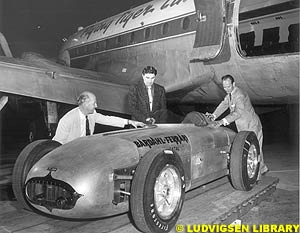 As Ferrari's success as a racing car manufacturer grew, both in sports cars and in Grand Prix racing, it was the profits from the sale of Ferrari road cars being built on the production line in Maranello that became increasingly important to the company as the customer cars financed the racing. The significance of the American market was reflected in some of the model names given to the most cherished and powerful Ferrari Gran Turismo sports cars: the California Spyder convertible, the 275 America, the 410 SuperAmerica and the Daytona. Even today, the American market is key to Ferrari where approximately 30% of the 4,300 cars Ferrari produced in 2001 were sold.
As Ferrari's success as a racing car manufacturer grew, both in sports cars and in Grand Prix racing, it was the profits from the sale of Ferrari road cars being built on the production line in Maranello that became increasingly important to the company as the customer cars financed the racing. The significance of the American market was reflected in some of the model names given to the most cherished and powerful Ferrari Gran Turismo sports cars: the California Spyder convertible, the 275 America, the 410 SuperAmerica and the Daytona. Even today, the American market is key to Ferrari where approximately 30% of the 4,300 cars Ferrari produced in 2001 were sold.
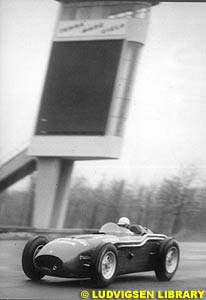 When the 1952 Grand Prix season was being organized, Alfa Romeo announced that it was going to withdraw from racing and because the other cars like the Talbot, Simca-Gordini, Maserati and ERA available to challenge the Ferrari were not serious contenders, the sporting authorities decided to run their races as Formula Two races for smaller 2 litre unsupercharged engines, which would hopefully create larger and more competitive fields. So strangely, for the 1952 and 1953 seasons, Formula One became Formula two.
When the 1952 Grand Prix season was being organized, Alfa Romeo announced that it was going to withdraw from racing and because the other cars like the Talbot, Simca-Gordini, Maserati and ERA available to challenge the Ferrari were not serious contenders, the sporting authorities decided to run their races as Formula Two races for smaller 2 litre unsupercharged engines, which would hopefully create larger and more competitive fields. So strangely, for the 1952 and 1953 seasons, Formula One became Formula two.
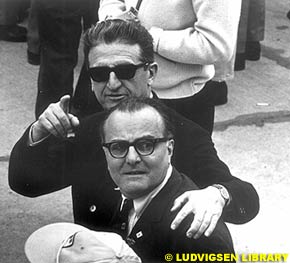 As luck would have it, Ferrari had unfortunately chosen a particularly competitive year to enter the fray at the Indy 500. There were two star cars of the race other than the Ferrari Special: first, an entirely new "lay-down" Kurtis-Kraft roadster called the Cummins Diesel Special which was built to showcase the turbocharged Cummins engine which was offset and laid on its side to lower the center of gravity and it qualified at 138.010 mph; and second, the Novi Pure Oil Special, a traditional crowd pleaser at Indy, whose supercharged front-wheel drive configuration carried it to a qualifying speed of 138.034 mph. By contrast, the more conventional Offenhauser-powered front-engined roadsters built by Kuzma, Lesovsky and Watson were mostly qualifying in the 134-136 mph range, with Ascari qualifying in the lower part of that range at 134.308 mph.
As luck would have it, Ferrari had unfortunately chosen a particularly competitive year to enter the fray at the Indy 500. There were two star cars of the race other than the Ferrari Special: first, an entirely new "lay-down" Kurtis-Kraft roadster called the Cummins Diesel Special which was built to showcase the turbocharged Cummins engine which was offset and laid on its side to lower the center of gravity and it qualified at 138.010 mph; and second, the Novi Pure Oil Special, a traditional crowd pleaser at Indy, whose supercharged front-wheel drive configuration carried it to a qualifying speed of 138.034 mph. By contrast, the more conventional Offenhauser-powered front-engined roadsters built by Kuzma, Lesovsky and Watson were mostly qualifying in the 134-136 mph range, with Ascari qualifying in the lower part of that range at 134.308 mph.
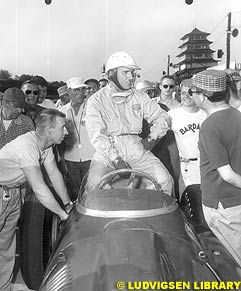 Ascari had some consolation coming his way that year, however; when he returned home he went on to win the 1952 World Championship and all six of the European Grands Prix in 1952 in his Ferrari 500 F2 car, missing out only on the Swiss Grand Prix, which Ascari passed up in favor of running at Indy.
Ascari had some consolation coming his way that year, however; when he returned home he went on to win the 1952 World Championship and all six of the European Grands Prix in 1952 in his Ferrari 500 F2 car, missing out only on the Swiss Grand Prix, which Ascari passed up in favor of running at Indy.
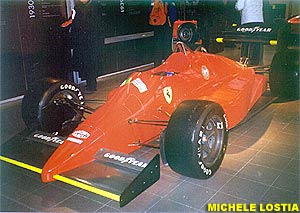 As in 1952, it was a rushed affair, though interestingly, pictures show that the team had time for certain things: the car had the "Kurtis" chassis insignia and chrome grille surround on its nose when it was airfreighted into Indianapolis but by the time it was ready to qualify "Kurtis" had been replaced with the Ferrari prancing horse symbol on the nose of the car. But Farina, who like Ascari before him was a rookie coming up the learning curve at Indy, never got to take the checkered flag as he was left waiting in line when the last day of qualifying was rained out. This car did have one achievement. Bob Said set a speed record of 170.5 mph on the sands of Daytona Beach with the Bardahl-Ferrari.
As in 1952, it was a rushed affair, though interestingly, pictures show that the team had time for certain things: the car had the "Kurtis" chassis insignia and chrome grille surround on its nose when it was airfreighted into Indianapolis but by the time it was ready to qualify "Kurtis" had been replaced with the Ferrari prancing horse symbol on the nose of the car. But Farina, who like Ascari before him was a rookie coming up the learning curve at Indy, never got to take the checkered flag as he was left waiting in line when the last day of qualifying was rained out. This car did have one achievement. Bob Said set a speed record of 170.5 mph on the sands of Daytona Beach with the Bardahl-Ferrari.
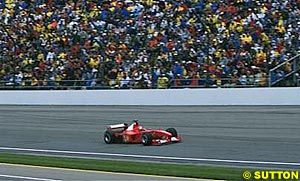 Although Ferrari did not make a run at Indy in the 1960's, he and Chinetti, his man in America, nonetheless kept the pot boiling and kept the Ferrari name in the headlines in the North American market. In the course of the 1964 Formula One season, Ferrari's lead driver, John Surtees, in his Ferrari 158 V8, was in a nip and tuck struggle for the World Championship with Graham Hill's BRM P261 V8. Midway through the season, Enzo became embroiled in a technical dispute with the sporting authorities over homologation of his Ferrari sports car and surrendered the competition license for the official Ferrari factory team for the last two Formula One races of the season, which were to be held in Watkins Glen, New York and Mexico City, Mexico. But of course, Ferrari did not want to jeopardize the chances of Surtees to win the World Championship so he had the Ferrari factory cars re-sprayed in white and blue - American racing colors - and the cars were entered this time around under the competition license of, guess who, Luigi Chinetti, as the official entry of N.A.R.T., the North American Racing Team. It again reflects Ferrari's affinity for America that his cars took the 1964 World Championship in American racing colors at the Mexican Grand Prix, the last race of the season, with Surtees winning out over Hill by one point.
Although Ferrari did not make a run at Indy in the 1960's, he and Chinetti, his man in America, nonetheless kept the pot boiling and kept the Ferrari name in the headlines in the North American market. In the course of the 1964 Formula One season, Ferrari's lead driver, John Surtees, in his Ferrari 158 V8, was in a nip and tuck struggle for the World Championship with Graham Hill's BRM P261 V8. Midway through the season, Enzo became embroiled in a technical dispute with the sporting authorities over homologation of his Ferrari sports car and surrendered the competition license for the official Ferrari factory team for the last two Formula One races of the season, which were to be held in Watkins Glen, New York and Mexico City, Mexico. But of course, Ferrari did not want to jeopardize the chances of Surtees to win the World Championship so he had the Ferrari factory cars re-sprayed in white and blue - American racing colors - and the cars were entered this time around under the competition license of, guess who, Luigi Chinetti, as the official entry of N.A.R.T., the North American Racing Team. It again reflects Ferrari's affinity for America that his cars took the 1964 World Championship in American racing colors at the Mexican Grand Prix, the last race of the season, with Surtees winning out over Hill by one point.
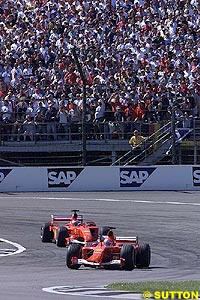 On September 24, 2000, the inaugural SAP United States Grand Prix took place and Ferrari finally won at Indianapolis in great style, after dominating qualifying on Saturday afternoon when Michael Schumacher qualified on pole. As the drivers familiarized themselves during practice and qualifying with a track that was brand new to all of them, Ferrari teammates Michael Schumacher and Rubens Barrichello put on quite a show for the fans by building up speed on the long run out of the infield and down the banking, slipstreaming each other down the main straightaway to give one another a tow that would add that extra bit of aerodynamical assist to turn in a good lap. With five laps left in the race, Schumacher made a rare mistake and spun in the wet grass on one of the infield turns that gave the Tifosi a bit of a fright but the now five-time World Champion ultimately clambered back onto the course and still finished in first place, with teammate Barrichello finishing in second, a total victory for the team that had gone home empty to Maranello so many times from the Speedway.
On September 24, 2000, the inaugural SAP United States Grand Prix took place and Ferrari finally won at Indianapolis in great style, after dominating qualifying on Saturday afternoon when Michael Schumacher qualified on pole. As the drivers familiarized themselves during practice and qualifying with a track that was brand new to all of them, Ferrari teammates Michael Schumacher and Rubens Barrichello put on quite a show for the fans by building up speed on the long run out of the infield and down the banking, slipstreaming each other down the main straightaway to give one another a tow that would add that extra bit of aerodynamical assist to turn in a good lap. With five laps left in the race, Schumacher made a rare mistake and spun in the wet grass on one of the infield turns that gave the Tifosi a bit of a fright but the now five-time World Champion ultimately clambered back onto the course and still finished in first place, with teammate Barrichello finishing in second, a total victory for the team that had gone home empty to Maranello so many times from the Speedway.
Please Contact Us for permission to republish this or any other material from Atlas F1.
|
Volume 8, Issue 39
Atlas F1 Exclusive
Interview with Mark Webber
Articles
50 Years of Ferrari at Indy
Jo Ramirez: a Racing Man
United States GP Preview
The US GP Preview
Local History: US Grand Prix
US Facts, Stats and Memoirs
Columns
The US GP Quiz
Bookworm Critique
The F1 FAQ
Elsewhere in Racing
The Grapevine
> Homepage |